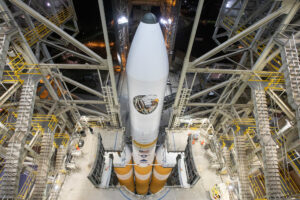ULA’s Delta 4 Heavy down to final five missions

WASHINGTON — As United Launch Alliance prepares for the last launch of its Delta 4 Medium rocket Thursday, the company is also counting down its final five missions with the Delta 4 Heavy.
Gary Wentz, ULA’s vice president of government and commercial programs, said the last Delta 4 heavy mission is currently slated for the second half of 2023.
“We’ve got two heavies scheduled right now targeting June and September of next year,” Wentz said during an Aug. 20 teleconference about Thursday’s planned GPS-3 launch. “Then we’ve got two scheduled in the latter part of [20]22 and the final is targeting a 2023 launch.”
A ULA spokesperson said all future Delta 4 Heavy missions are to “support our U.S. Air Force/National Reconnaissance Office customer.”
The two Delta 4 Heavy launches planned for 2020 are the National Reconnaissance Office’s NROL-44 mission out of Cape Canaveral, Florida, and NROL-82 out of Vandenberg Air Force Base, California, according to Spaceflightnow.com.
ULA is also building Delta 4 Heavy hardware for three NRO missions under a 2018 Launch Vehicle Production Services contract now worth $467.5 million following a $149 million modification in May and a $156.7 million modification earlier this month.
Additional contract awards are expected in coming months to cover the actual launches of NROL-70 and NROL-91 in 2022 and NROL-68 in 2023.
ULA is phasing out the Delta 4 Heavy in favor of Vulcan, its next-generation rocket which Wentz said will first fly in April 2021. The Delta 4 Heavy is an expensive rocket, costing upwards $350 million a launch, limiting its use to government customers. While ULA’s Delta 4 Heavy’s price has reportedly fallen below $300 million, it’s still considered too expensive to be commercially viable.
For certain government payloads, such as big-ticket spy satellites, Delta 4 Heavy remains an attractive ride.
“We’re continuing to fly the Delta 4 Heavy out through the latter part of 2023 for specific payloads that require that capability and that mission success assurance that we provide,” he said. “We will continue to fly those as long as the customer sees the need, and we have planned an on-ramp for Vulcan Centaur to provide us some overlap for that capability to give some additional redundancy to our customers.”
Delta 4 Heavy uses three liquid-propellant rocket boosters on its first stage in order to loft 14,200 kilograms to geostationary transfer orbit. The rocket’s lift capacity was unrivalled in the U.S. until SpaceX’s introduction of the Falcon Heavy last year, which can loft 26,700 kilograms to that orbit, also using three liquid-fueled rocket cores.
Delta 4 Heavy has launched 11 times since its 2004 introduction. Aside from lower-than-expected performance on its debut mission, the heavy-lift rocket — like the rest of ULA’s current fleet — has not suffered a failure.
ULA’s Delta 4 Medium, which uses one liquid-propellant first stage supplemented by smaller solid-fueled boosters, has launched 28 times. Its 29th and final mission will carry the Air Force’s second GPS-3 satellite Aug. 22.
from SpaceNews.com https://ift.tt/2Mxm1qQ
Comments
Post a Comment